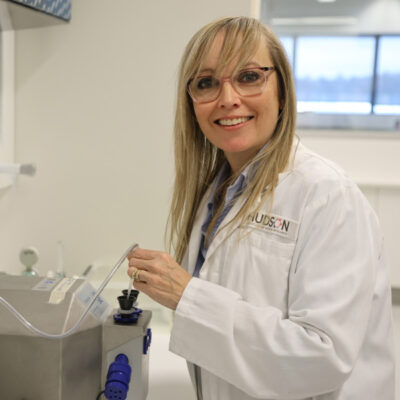Fetal growth restriction treatment findings
By Hudson Institute communications
Treatments given postnatally to babies who have experienced fetal growth restriction (FGR) during pregnancy need to be carefully considered, following new light shed on the topic by cell therapy research.

FGR puts babies at high-risk of damage to their lungs, cardiovascular system and brain.
A Hudson Institute preclinical study of umbilical cord blood cells found the cells were effective at improving lung injury in appropriately grown, but not as effective in growth restricted births.
Dr Beth Allison, first author of the study published in the journal, Frontiers in Endocrinology, said it was an important finding.
“It shows that fetal growth restriction treatments need to be investigated to determine if they are effective specifically for growth restricted infants,’’ Dr Allison said.
Fetal growth restriction occurs when the womb does not supply the developing baby with enough nutrients and oxygen to ensure that it grows to its full potential.
Many organs, including the lung have impaired development when the baby’s growth is restricted.
After birth, the baby is at a greater risk of needing medical assistance due to the impaired growth in the womb.
Cord blood treatment for growth restricted newborns
This study was one of the first to test the efficacy of umbilical cord blood stem cells treatment to reduce lung injury following birth in growth restricted newborns.
“Our study is the first to highlight that the fetal growth restricted infant responds differently to cell therapy, and these results suggest that the health of the environment in which the fetus grows needs to be considered when giving postnatal treatments,” Dr Allison said.
“Our research suggests that therapies applied in the neonatal period cannot be ‘one-size-fits-all’.
“There is a growing body of research showing that growth restricted infants need to be considered as a separate population of infants, they are not merely smaller versions of an appropriately grown baby,” she said.
“This, and other similar research shows that we need targeted research which specifically aims to understand the effects of medical treatments and therapies on growth restricted newborns.”
About FGR
- Affects more than 20,000 Australian babies per year
- Up to 20 per cent of babies born globally affected each year
- Can cause cardiovascular disease, lung and brain injury, cognitive, learning and behavioural problems, cerebral palsy and autism
- FGR infants have up to 20 times the risk of morbidity or perinatal mortalities at any gestational age compared to infants who are appropriately grown (AG).
Collaborators | Monash Health
Funders | NHMRC
Contact us
Hudson Institute communications
t: + 61 3 8572 2697
e: communications@hudson.org.au
In this article
About Hudson Institute
Hudson Institute’ s research programs deliver in three areas of medical need – inflammation, cancer, women’s and newborn health. More
Hudson News
Get the inside view on discoveries and patient stories
“Thank you Hudson Institute researchers. Your work brings such hope to all women with ovarian cancer knowing that potentially women in the future won't have to go through what we have!”






